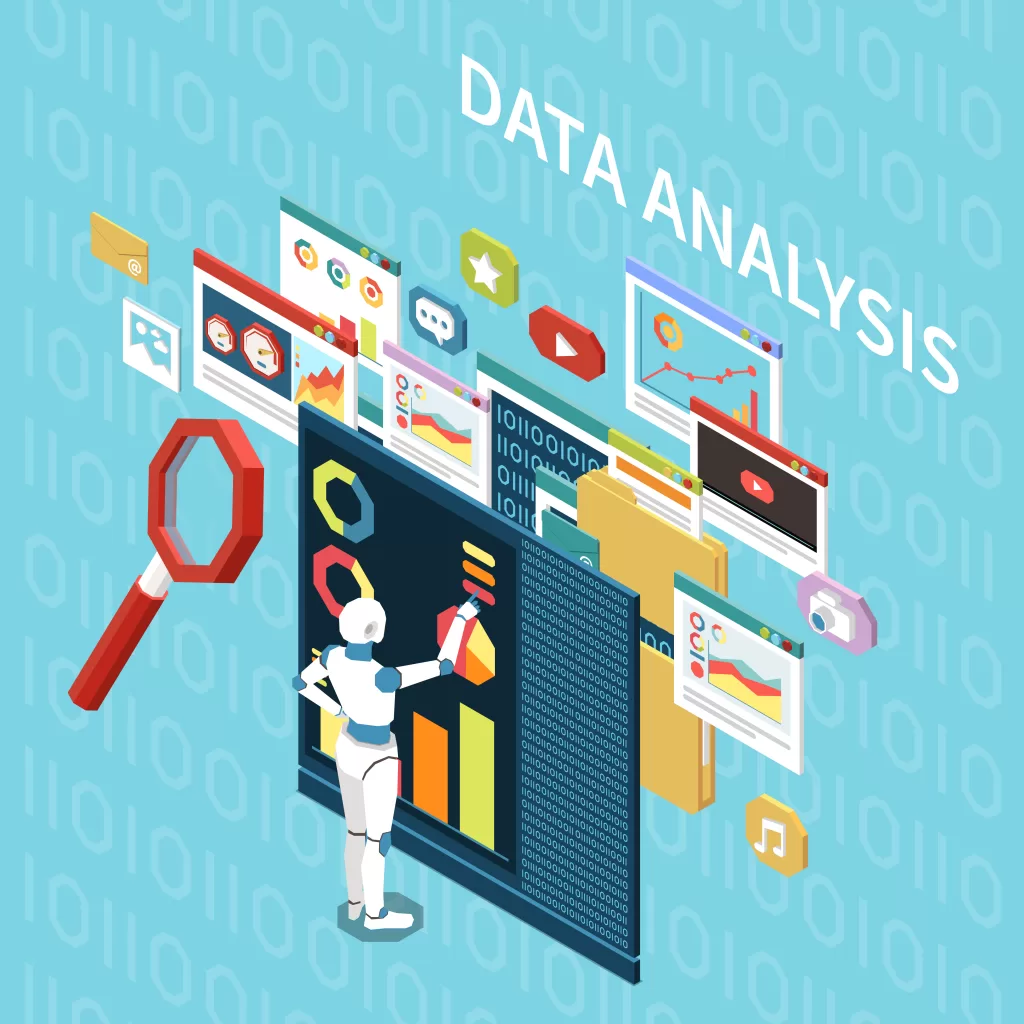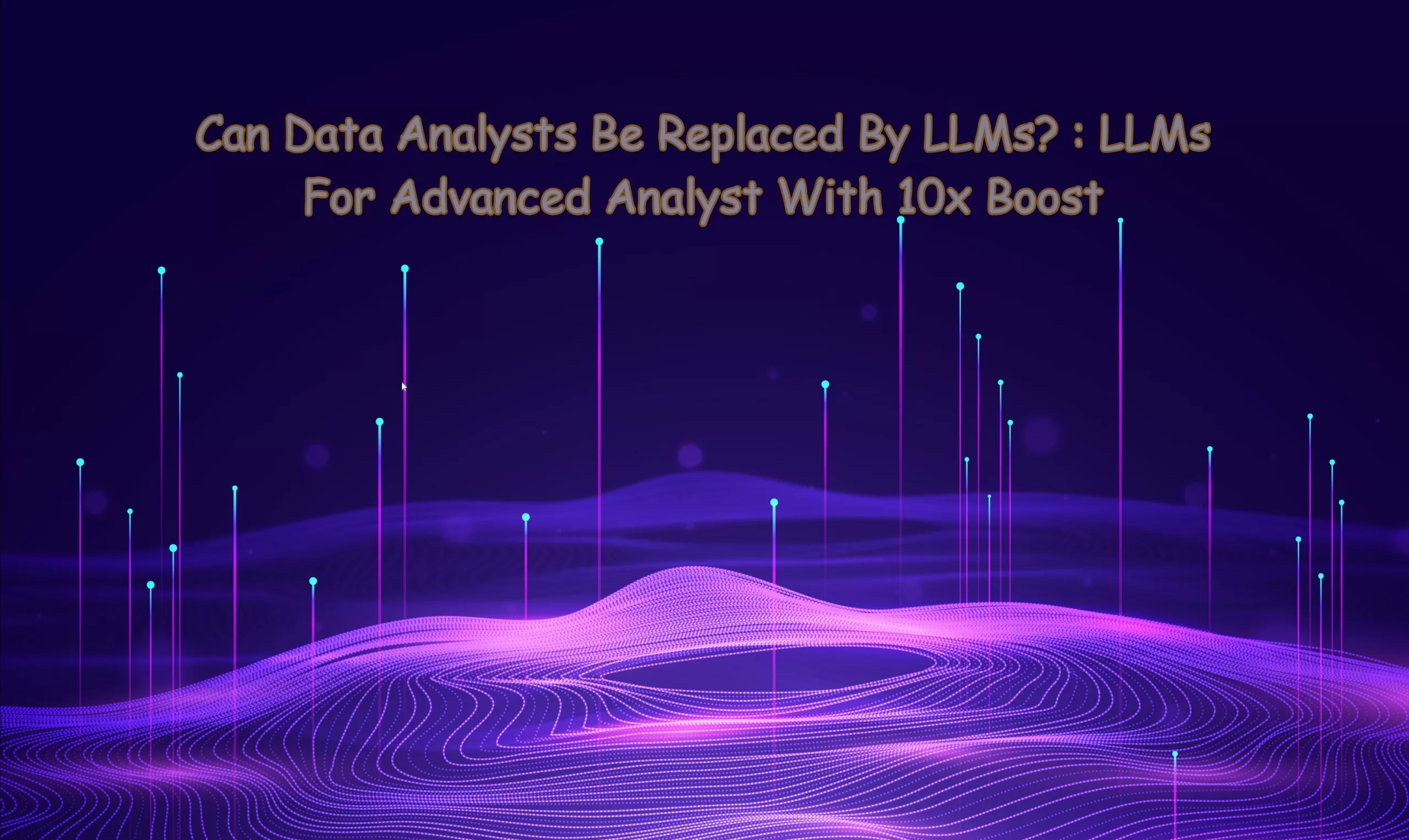Can Data Analysts Be Replaced by LLMs? : LLMs for Advanced Analyst with 10x Boost
From Data To Decisions : LLMs For Advanced Data Analyst With 10x Boost
The advent of Language Model (LM) technology in recent years has raised debates about how it can transform a number of industries, including data analysis. Large Language Models (LLMs) such as GPT-3 have advanced automated language processing to unprecedented levels, raising concerns about whether LLM-powered systems could eventually take the place of human data analysts. The capabilities of LLMs in data analysis, their potential to support human analysts, and the difficulties and factors to be taken into account while developing an LLM-powered analyst will all be covered in this paper.
Most of us agree that the latest developments in generative AI will have a significant impact on both our personal and professional life. On the other hand, it is currently unclear how our responsibilities will evolve.
In this post, we’ll start out small and discover how LLMs can use tools to complete simple tasks. However, we shall delve further into various strategies and best practices for LLM agents in the upcoming posts.
Understanding Data Analytics
First, let understand what is Analytics and how Analyst are using it?
Analyzing raw data to find relevant patterns, trends, and insights that might inform choices and spur corporate expansion is known as data analytics. It entails utilizing a variety of methods and instruments to examine vast amounts of data, draw insightful conclusions, and extract important information.
Fundamentally, data analytics comprises three primary categories:
Descriptive Analysis :
Summarizing historical data to offer insights into past events is the main goal of descriptive analytics. To identify patterns and trends, it uses methods including data mining, data aggregation, and visualization. “What happened?”-type queries are addressed by descriptive analytics, which also establishes the framework for more research.
Predictive Analysis :
Statistical algorithms and past data, analyzed by data analysts, are used in predictive analytics to project future patterns and results. Predictive analytics helps businesses predict the future and take preventive measures by finding patterns and connections in data. It provides answers to queries such as “What is likely to happen?” and supports risk and strategy planning.
Prescriptive Analytics :
Prescriptive analytics is a data analysis technique that goes beyond simple prediction of future events to include actionable recommendations for optimizing outcomes. To deliver useful insights, it makes use of cutting-edge algorithms, machine learning strategies, and optimization models. Prescriptive analytics provides answers to queries like “What should we do?” and gives organizations the confidence to make data-driven decisions.
Understanding LLMs and Data Analysis
AI programs that have been trained on enormous volumes of text data to produce text that resembles that of a human are called Large Language Models (LLMs). These models are quite good at tasks like question answering, translation, summarization, and text production. But its use in data analysis, although promising, doesn’t fully replace the expertise and insights provided by a human data analyst.
Large datasets may be ingested, processed, and analyzed by LLMs, which can then be used to derive insights, spot patterns, and make predictions. They can carry out activities usually performed by data analysts, like exploratory data analysis, predictive modeling, and report generation, by comprehending the context and subtleties of the data.

The Potential of LLM-Powered Data Analysis
Natural Language Interaction
With conversational interfaces, LLMs facilitate natural language interaction with data, enabling users to query and explore databases. This accessibility makes data access and analysis within companies more accessible to non-technical individuals by lowering the entry barrier.

Scalability
Due to their tremendous scalability, LLMs can manage a wide range of datasets from different domains with little to no manual configuration or customization required. Organizations are able to generate comprehensive insights by analyzing data from various sources at once, but the expertise of a human data analyst remains essential for accurate interpretation and meaningful insights.
Automation of Routine Tasks
Regular data analysis tasks, including outlier detection, data cleansing, and basic statistical analysis, can be automated by LLMs. Human analysts can concentrate on more intricate and crucial areas of analysis by automating these procedures, which will increase overall productivity and efficiency.
Speed and Efficiency
Organizations can handle massive volumes of data in a fraction of the time it would take a data analyst to process them using traditional ways thanks to LLMs’ significantly faster data analysis speed than humans. This speed can be very useful for managing large databases and making decisions in real time.
Using LLMs to Support Human Analysts
Even though LLMs have many benefits when it comes to data analysis, they are not meant to completely replace human analysts. Alternatively, they can supplement human analysts’ abilities to improve their efficacy and efficiency in a number of ways:
Assisted Analysis:
By automating tedious activities, offering insights, and supplying contextually relevant data throughout the analysis process, LLMs can support human analysts. Workflows are streamlined by this help, freeing analysts to concentrate on more complex analytical projects.
Complex Pattern Recognition:
LLMs are particularly good at finding intricate connections and patterns in data that can be hard for human analysts to see. Through utilizing LLMs’ computational capacity, researchers can unearth undiscovered patterns and arrive at better educated conclusions.
Enhanced Data Exploration:
Through natural language interfaces, LLMs can enable interactive data exploration, empowering data analysts to ask sophisticated questions, display data, and develop deeper understanding through iterative exploration. This feature facilitates a more intuitive interpretation of data and speeds up the process for data analysts to find insights.
Continuous Learning and Adaptation:
LLMs have the ability to continuously learn from fresh data and modify their analytical models as necessary. By keeping up with dynamic datasets and shifting trends, analysts can maintain the accuracy and relevance of their research throughout time thanks to adaptive learning.
Challenges and Considerations
Despite the potential of LLMs in data analysis, several challenges and considerations must be addressed when building an LLM-powered analyst:
Data Quality and Bias:
Training data can contain biases that affect LLMs, which can produce biased or incorrect analytical outcomes. Maintaining the integrity and dependability of LLM-powered analysis requires both ensuring data quality and putting policies in place to reduce bias.
Interpretability and Transparency:
Because LLMs function as “black-box” models, it is challenging to understand how they make decisions. Building trust and promoting collaboration between LLMs and human analysts requires improving the interpretability and transparency of LLM-powered analysis.
Domain Expertise and Contextual Understanding:
Domain Expertise and Contextual Understanding: The relevance and accuracy of data analyst analysis in specialized domains may be impacted by LLMs’ lack of domain-specific knowledge and contextual understanding. This problem can be solved by incorporating domain knowledge into LLM-powered systems and offering context-aware analytic tools.
Ethical and Privacy Considerations:
LLMs may run into moral conundrums and privacy issues, especially when examining private or sensitive data. To guarantee the responsible and ethical use of LLM-powered analysis, it is imperative to implement strong ethical norms, privacy-preserving strategies, and compliance mechanisms.
Applications Across Industries
LLM agents and tools have diverse applications across industries, revolutionizing the way organizations analyze and leverage data:
Finance:
LLM agents can help with market trend analysis, fraud detection, and risk assessment in the finance sector. These technologies assist financial organizations in reducing risks and making well-informed investment decisions by evaluating textual data from news stories, financial reports, and social media.
Healthcare:
Data analysts play a crucial role in healthcare analytics, leveraging LLM agents and tools to analyze electronic health records, medical literature, and patient input. These technologies drive various healthcare applications aimed at improving patient outcomes and reducing healthcare costs, such as forecasting disease outbreaks and personalizing treatment regimens.
E-commerce:
LLM agents help with demand forecasting, consumer sentiment research, and personalized suggestions in the e-commerce industry. Through the examination of product reviews, social media discussions, and buying trends, these solutions assist e-commerce platforms in improving user experiences, boosting sales, and streamlining inventory control.
Marketing:
Data analysts can leverage LLM agents and tools to gain insights into customer behavior, market trends, and competitive analysis. These technologies analyze online reviews, social media interactions, and customer feedback, aiding in marketing strategy, campaign optimization, and brand perception management. However, human expertise remains crucial in interpreting complex data accurately.
Conclusion:
Even though LLMs have a lot of potential for data analysis, it is best to use them as tools to support human analysts rather than to completely replace them. Through the utilization of LLMs’ advantages in speed, scalability, and pattern identification, entities can augment the efficacy and efficiency of their data analysis protocols. To fully reap the rewards of LLM-powered analysis, however, issues like data quality, interpretability, and ethical problems must be resolved. An LLM-powered analyst can be a useful ally in gaining insights from data and promoting well-informed decision-making across a range of disciplines with proper preparation and integration.



